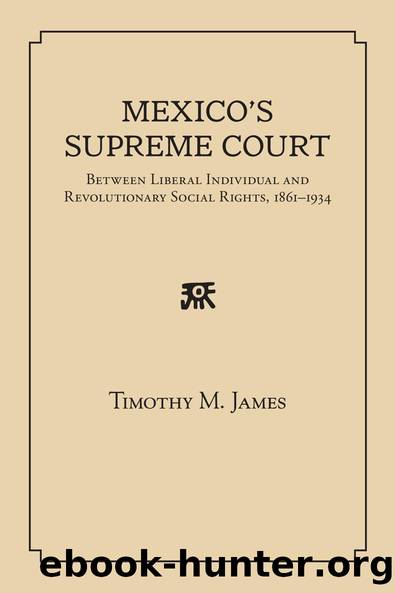Mexico's Supreme Court by Timothy M. James

Author:Timothy M. James [James, Timothy M.]
Language: eng
Format: epub
Tags: History, Latin America, Mexico, Law, Legal History
ISBN: 9780826353795
Google: qRVBAQAAQBAJ
Publisher: UNM Press
Published: 2013-12-01T03:09:17+00:00
The Reversal of the Original Jurisprudence
It was the constitutional vision of the boards, promoted by the state legislatures and organized labor (especially the CROM), that would eventually triumph, though not until the appointment of a third Supreme Court. The election itself, drawn out over several months in the summer of 1923, was the most openly contested of the period, partly because these justices would now enjoy lifetime tenure but also because there was a significant fissure developing among various Revolutionary groups over the presidential succession of 1924. So severe was the contestation that it led to a stalemate between the Chamber of Deputies, which was controlled by the PNC (Partido Nacional Cooperatista, or National Cooperative Party) majority, and the Senate, during which time the Supreme Court ceased to function (its constitutional powers ending on June 1, 1923). Eventually the PNC majority reached a compromise with the Senate and was able to elect a majority of their candidates, reconstituting the Court on July 27, 1923, with several openly declared PNC favorites, including Francisco M. RamÃrez, Jesús Guzmán Vaca, Manuel Padilla, and Ricardo B. Castro.57 Only Ernesto Garza Pérez, former state congressman for Coahuila and secretary of foreign relations under Carranza, and Gustavo A. Vicencio, president of the Court from 1922 to 1923, were retained from the previous Court.58 There is no evidence that the question of the labor boards was an explicit criterion for selecting these new justices (in fact, quite the opposite). Indeed, Victoriano Pimentel, one of the justices who was most responsible for the original jurisprudence, was not reelected to the Court in 1919 but was reelected in 1923. Also, Justice González, who openly declared for a reversal of the old jurisprudence between 1921 and 1923, was not reelected. Finally, those justices who were retained from the previous Court were initially against altering this established jurisprudence. By electing a majority of new justices, however, a new Supreme Court was to address this question of the labor boards with new eyes and at a time when the importance of the political support of organized labor had become a central feature of a new mass politics.
In December 1923 the crisis over the presidential succession had devolved into an open rebellion led by President Obregónâs former treasury secretary, Adolfo de la Huerta, and key leaders of both the PNC and the PLC. A majority of the army had rallied to de la Huertaâs cause and Obregón had been forced (albeit reluctantly) to rely heavily on irregulars such as armed campesino militias and the support of organized labor.59 In the month of January, at the high-tide mark of the rebellion, the Court was faced for the first time with two cases that openly raised the question of the constitutional limits to the labor boards. The first of these was the Carlos DÃaz Ordaz case, admitted by the Court by an eight-to-two majority vote on January 12, 1924, but reserved for substantive discussion at the first secretaryâs next turn.60 On January 18, 1924, another
Download
This site does not store any files on its server. We only index and link to content provided by other sites. Please contact the content providers to delete copyright contents if any and email us, we'll remove relevant links or contents immediately.
Cat's cradle by Kurt Vonnegut(14795)
Pimp by Iceberg Slim(13812)
Underground: A Human History of the Worlds Beneath Our Feet by Will Hunt(11850)
4 3 2 1: A Novel by Paul Auster(11825)
The Radium Girls by Kate Moore(11644)
Wiseguy by Nicholas Pileggi(5340)
American History Stories, Volume III (Yesterday's Classics) by Pratt Mara L(5142)
Perfect Rhythm by Jae(5085)
The Fire Next Time by James Baldwin(5034)
Paper Towns by Green John(4817)
Pale Blue Dot by Carl Sagan(4639)
A Higher Loyalty: Truth, Lies, and Leadership by James Comey(4569)
The Mayflower and the Pilgrims' New World by Nathaniel Philbrick(4289)
The Doomsday Machine by Daniel Ellsberg(4254)
Killers of the Flower Moon: The Osage Murders and the Birth of the FBI by David Grann(4200)
Too Much and Not the Mood by Durga Chew-Bose(4107)
The Sympathizer by Viet Thanh Nguyen(4102)
The Borden Murders by Sarah Miller(4033)
Sticky Fingers by Joe Hagan(3919)
